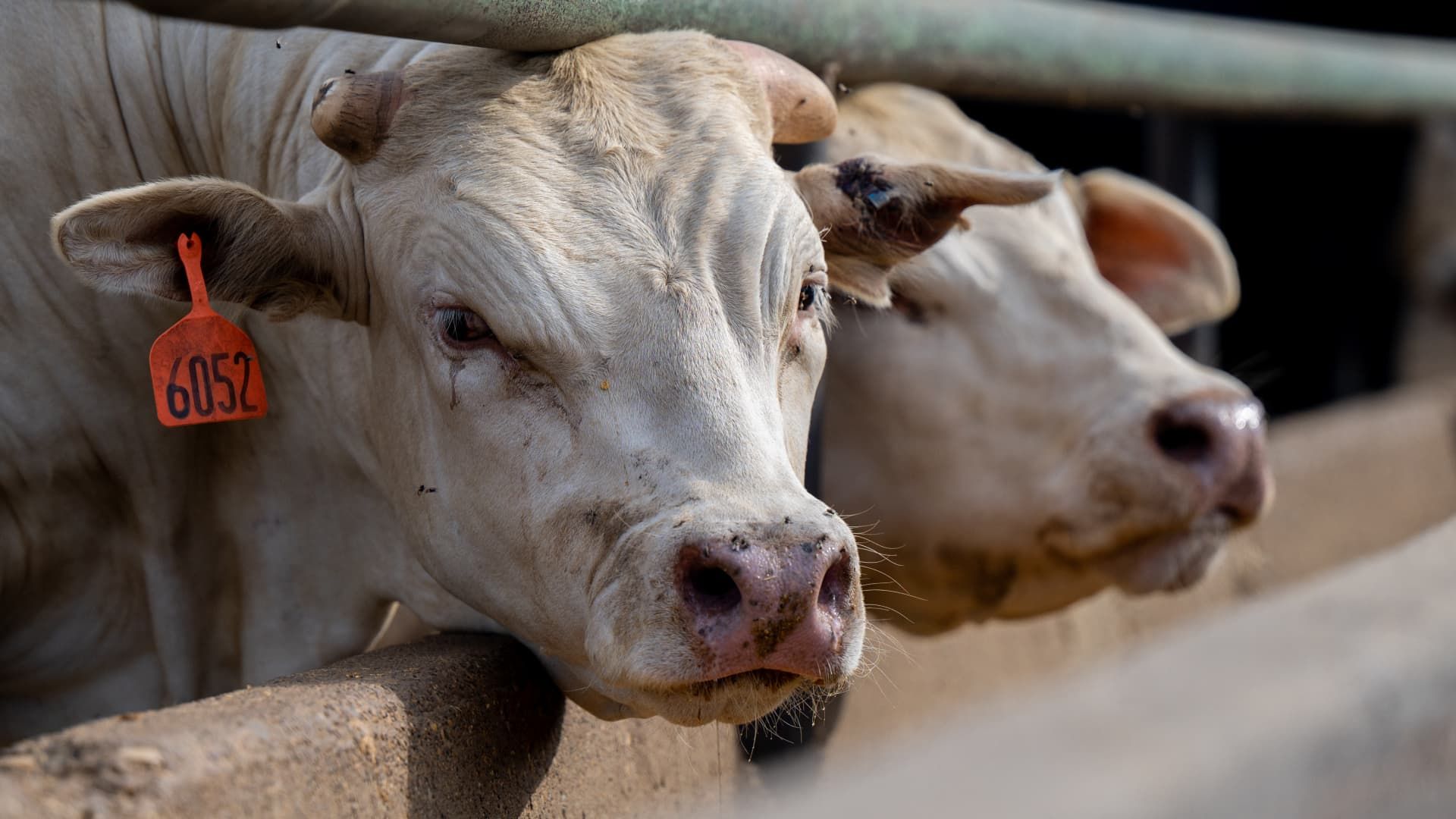Cows are seen standing in a feedlot on June 14, 2023 in Quemado, Texas.
Brandon Bell | fake images
U.S. health officials are monitoring and preparing to combat bird flu in humans, even as they emphasize that the risk to the general public remains low.
A strain of bird flu called H5N1 has been confirmed in dairy cows in nine US states, along with two people, amid an ongoing global outbreak among poultry and other animals. The last case was a Michigan dairy farm worker announced Wednesday. An Australian child was also recently infected with bird flu, the country announced Tuesday.
H5N1 has been spreading among more animal species around the world since 2020, but its detection in American livestock earlier this year was a twist that health officials did not expect. In rare cases, bird flu viruses are transmitted to humans and can cause mild to severe symptoms that may require hospitalization.
There is currently no evidence that H5N1 is being transmitted from person to person. The Centers for Disease Control and Prevention has also said the risk of infection is higher among farm workers than the general population.
Still, the U.S. government, along with state and local health departments, are monitoring new and emerging infections among humans and animals. Federal agencies in the U.S. and elsewhere have also tracked the H5N1 virus for years to monitor its evolution.
The U.S. government has long stockpiled vaccines and medications for use in a possible bird flu pandemic. Last week, the process of preparing nearly 5 million vaccine doses expected to be compatible against H5N1 began, among other efforts to respond, the Department of Health and Human Services confirmed to CNBC.
Some infectious disease experts told CNBC that the U.S. government appears to be generally prepared if bird flu begins to spread more widely and easily to humans, especially compared to how equipped the country was for the pandemic. Covid. Experts said most of the necessary tools are already available, but the government must ensure it implements them effectively, if necessary.
“There are already a lot of pieces that help us understand that we can respond to this faster,” said Dr. Andrew Pekosz, a professor at the Johns Hopkins Bloomberg School of Public Health. “However, as is always the case, it's about the efficiency of our responses, right? We know what we can do. We just have to be able to do it effectively.”
The latest human infection in a Michigan dairy worker is not a surprise, according to experts and the government. The CDC said Wednesday that similar cases could be identified in humans because high levels of the virus have been found in the raw milk of infected cows.
Millions of vaccine doses
The US government currently has two vaccine virus candidates that it believes are compatible with H5N1. Those candidates are weakened versions of a virus that trigger a protective immune response against it in the body and can be used to produce vaccines.
Both candidates are now available to manufacturers, according to the CDC. Last week, the government began the process of manufacturing 4.8 million doses of those human vaccines in case they are needed, HHS confirmed.
Pekosz called those doses a “first line of defense in case we see any human-to-human transmission.” He said that number is enough to stop an outbreak in its early stages, which could include vaccinating farmworkers and some health care workers.
But he said much more is needed for the more than 300 million people in the United States if the virus spreads widely among humans.
“5 million doesn't really get us very far. It's just a quick start,” Pekosz said.
U.S. health officials said earlier this month that the government could ship more than 100 million doses of human bird flu vaccines within three to four months if needed, NBC News reported.
In particular, people will need two doses of a vaccine, meaning that 100 million doses are only enough for 50 million people. That suggests the United States would need roughly 600 million shots if it wanted to vaccinate the entire population.
The government faces a difficult decision about how many shots to prepare, especially since it takes a few months to deliver them.
“It's either too little or too much. For example, if too much food is produced, a lot of food is wasted,” said Dr. Peter Chin-Hong, an infectious diseases physician at UCSF Health. “That's really the big conundrum of a vaccine today, as long as there's a potential threat. It's the high-cost, high-risk aspects.”
He said misinformation and hesitancy about vaccines after Covid made that decision even more challenging. But Chin-Hong said he believes “you can never invest too much” in preparing for potential pandemics, especially at a time when climate change, population growth and other factors make them increasingly likely to occur.
The Food and Drug Administration would need to approve bird flu vaccines before they are rolled out. But Pekosz said it will likely be a “quick procedure” since the FDA is used to approving seasonal flu vaccines, which are made through the same manufacturing process as bird flu vaccines.
Possible mRNA injections
U.S. health officials are also in talks with messenger RNA vaccine makers about potential bird flu vaccines for humans. Few details have been shared about those negotiations, but HHS said a final announcement is expected soon.
Unlike traditional flu vaccines, mRNA works by teaching cells to produce a harmless part of a virus, which triggers an immune response against certain diseases. It is the same technology both Pfizer and modern have used in their Covid vaccines.
Chin-Hong said mRNA vaccines could be updated more quickly to match the bird flu strains currently circulating. But she said those vaccines have their own challenges, such as the need to store them at extremely cold temperatures.
In a statement to CNBC, Moderna confirmed that it is involved in negotiations with the government over its experimental pandemic influenza vaccine, mRNA-1018. She targets the exact strain of virus responsible for the outbreak in dairy cattle.
The biotech company began testing that vaccine in an early-to-mid stage last summer.
Pfizer declined to confirm negotiations with the government. The company said it continues to monitor the spread of H5N1 and study its mRNA-based pandemic influenza vaccine candidates in an initial trial.
Virus surveillance and treatments.
CDC and its partners, including state and local health departments, use multiple surveillance systems to monitor seasonal influenza and other illnesses. They also have specialized methods to detect and monitor new flu viruses.
Seasonal influenza spreads primarily among humans with predictable peaks throughout the year, while bird flu primarily spreads among wild birds and other animals.
The CDC said it is looking for the spread of H5N1 to or between people in areas where the virus has been identified in animals or humans. So far, the agency has not found “any indicators of unusual influenza activity in people,” including H5N1, according to an update on the agency's site last week.
CDC also conducts ongoing testing of new and seasonal influenza viruses to identify genetic changes that could allow them to cause more severe infections in humans, spread more easily from person to person and between people, or become less susceptible to vaccines and medications.
While there is strong evidence at the federal, state and local levels, it is much more difficult for the average person to self-test and receive a diagnosis for bird flu as it is for Covid. Chin-Hong said that's “the big barrier, particularly in the populations that are being affected now.”
Chin-Hong refers to farmworkers, a large proportion of whom are immigrants, who may have difficulty navigating the American healthcare system due to language barriers and access to healthcare.
If people contract the virus, there are some FDA-approved antiviral medications for seasonal flu that can be used for bird flu. That includes Tamiflu, which is an oral prescription medication that must be taken within 48 hours of symptoms appearing.
A Texas dairy farm worker who was diagnosed with bird flu in March was treated with an antiviral drug and recovered, according to a CDC report.
But Pekosz said the antiviral drugs in the country's stockpile are likely not enough for the vast majority of the population, so manufacturers could be asked to increase supply.
According to Francesca Torriani, a professor of clinical medicine at the University of California, San Diego, the average person can protect themselves from bird flu by avoiding any live or dead animals that may be infected, such as cattle or chickens.
People who need to come into contact with these animals should wear the appropriate mask and eye protection and then wash their hands.
Torriani added that pasteurized milk and cheese are probably safer to consume than raw dairy products, since the pasteurization process kills harmful bacteria.










